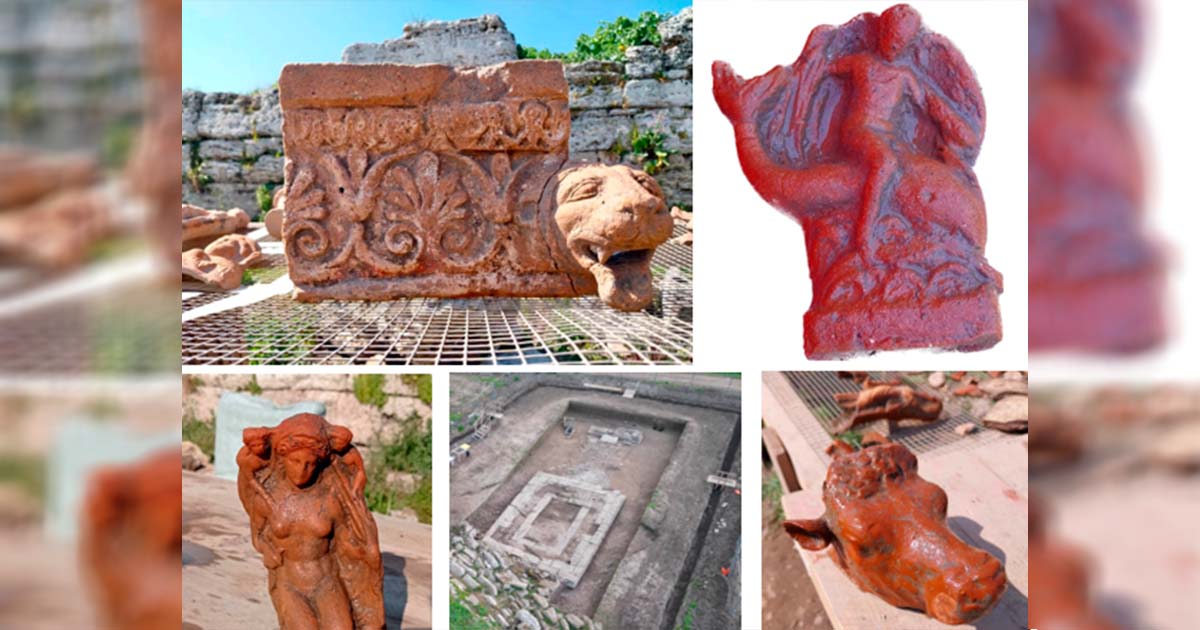Trove of Ancient Artifacts Discovered in Paestum Include Dolphin Statuette of Eros
Archaeological excavations in southern Italy have yielded a treasure trove of Greek artifacts from the ancient city of Paestum. Located on the famed Amalfi coast close to Pompeii, a ‘significant’ collection of artifacts has been found, including terracotta bull heads, and a figurine of the Greek god of love, Eros, riding a dolphin. This is the first time a discovery of this magnitude has been discovered at this site. A reem of new religious practices have been learnt all the way back from the 5th century BC onwards.
The Italian Paestum Culture Ministry announced that the small temple where the artifacts were discovered was initially identified in 2019 along the ancient city walls, according to an Associated Press report. With excavation work on hold due to the COVID-19 pandemic, the reporting of these discoveries has been slow. With the resumption of work, archaeologists were thrilled to find several small terracotta figurines in the first few months of digging.
- Archaeologists Uncover Evidence of Luxurious Lifestyle 5,000 Years Ago in Turkey
- Archaeologists Explore Incredible Ancient City in Supposed Backwater Region of Greece

The temple recently found next to the ancient city walls of Paestum. (Paestum Velia Archaeological Park)
Religious Practices: Animal Figurines and Animal Sacrifices
Among the most intriguing discoveries were seven bull heads found around a temple altar as if placed there on the ground in a form of devotion. This finding indicates that the ancient city's religious practices involved animal sacrifices as offerings to the gods. The bull was a significant animal in ancient Greek mythology and was considered a sacred symbol of strength and power. It was often associated with the god Zeus, who was believed to have taken the form of a bull on several occasions.

One of the bull heads found placed around the altar. (Paestum Velia Archaeological Park)
In addition to the bull heads, the archaeologists found a dolphin statuette, which appears to be from the Avili family of ceramists. This family's presence had never before been documented in Paestum, reports Sky News. The dolphin was an important symbol in ancient Greek mythology, and its depiction in the statuette suggests that it held significant religious significance for the people of Paestum.

Archaeologists have been particularly excited by this statuette of Eros riding a dolphin. (Paestum Velia Archaeological Park)
Limited excavations had taken place at the temples since the 1950s, but the Italian Culture Ministry believes that there may be more treasures to uncover in the area. The city was first settled by Greek colonists under the name of Poseidonia, which means the "city of Poseidon," after the Greek god of the sea.
- The Ancient Greek Symposium: Just an Excuse for Debauchery?
- Ancient Hellenic mosaic discovered in ‘the Hall of Dragons and Dolphins’
Poseidonia and Paestum: Early Settling by the Greeks and Romans
The city was founded in the 6th century BC by Greek colonists from Sybaris, who established a thriving community in the region. The city was known for its agriculture and commerce, reports Heritage Daily. It was also a center of Greek culture and learning, and attracted scholars and philosophers from all over the Mediterranean world.
The city was renowned for its medical practices, and the physician Alcmaeon of Croton was said to have practiced medicine there in the 5th century BC. The city's inhabitants were also skilled in pottery, and the Paestum pottery style was renowned for its fine quality and exquisite craftsmanship.

View of two of the Greek temples at Paestum. (Oliver-Bonjoch/CC BY-SA 3.0)
The three massive Doric-columned temples, which are still standing today, were dedicated to the gods Hera, Athena, and Poseidon, and are some of the best-preserved ancient Greek temples in the world. The temples were constructed using local limestone and marble, and boast of an impressive size and architectural style. The city's inhabitants believed that the gods had a significant impact on their daily lives, and they performed regular rituals and sacrifices to appease them.
In addition to the temples, Paestum was also home to a variety of other buildings, including public buildings, houses, and tombs. The city's tombs were particularly noteworthy, as they were often elaborately decorated with frescoes depicting scenes from everyday life, mythology, and the afterlife.
The city's influence waned in the 4th century BC as it came under the control of the Lucanians, an ancient Italic people. In the 3rd century BC, the city was conquered by the Romans, who renamed it Paestum from the Greek "Poseidonia." Despite its decline in importance, the city continued to be inhabited until the 9th century AD when it was abandoned due to the threat of Saracen raids.
Top image: A variety of artifacts from the newly found temple at the Paestum Velia archaeological park. Source: Paestum Velia Archaeological Park
By Sahir Pandey
References
Associated Press. 2023. Archaeologists in Italy unearth ancient dolphin statuette. Available at: https://www.cbsnews.com/news/archeologists-italy-unearth-ancient-dolphin-statuette/.
Milligan, M. 2023. ANCIENT GREEK TEMPLE DISCOVERY SHEDS NEW LIGHT ON RITUAL ACTIVITIES IN ANCIENT PAESTUM. Available at: https://www.heritagedaily.com/2023/04/ancient-greek-temple-discovery-sheds-new-light-on-ritual-activities-in-ancient-paestum/146941.
Sky. 2023. Greek god of love and sex riding a dolphin among artefacts unearthed at ancient city of Paestum. Available at: https://news.sky.com/story/greek-god-of-love-and-sex-riding-a-dolphin-among-artefacts-unearthed-at-ancient-city-of-paestum-12858623.


















Comments
"This finding indicates that the ancient city's religious practices involved animal sacrifices as offerings to the gods."
No, it doesn't. That's just the narrative, which is far-fetched. If objects like that existed today, maybe made in China, would it 'indicate' that?
Nobody gets paid to tell the truth.